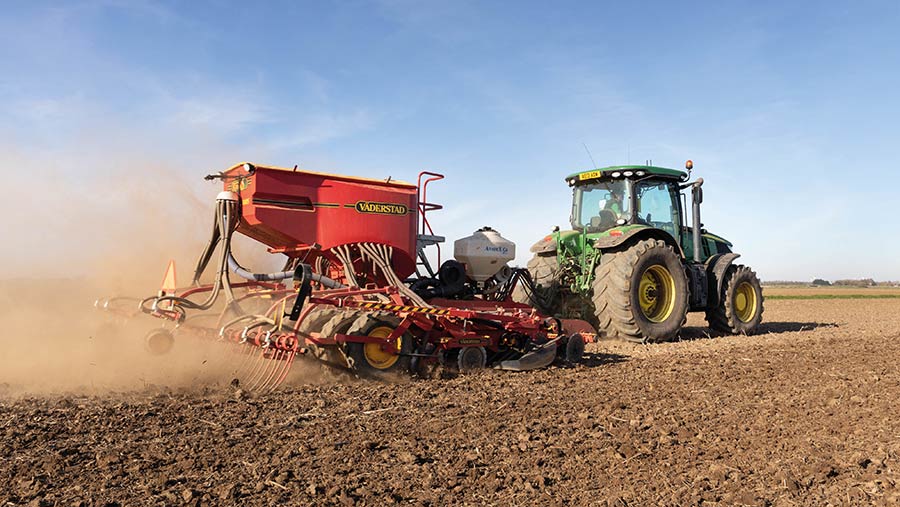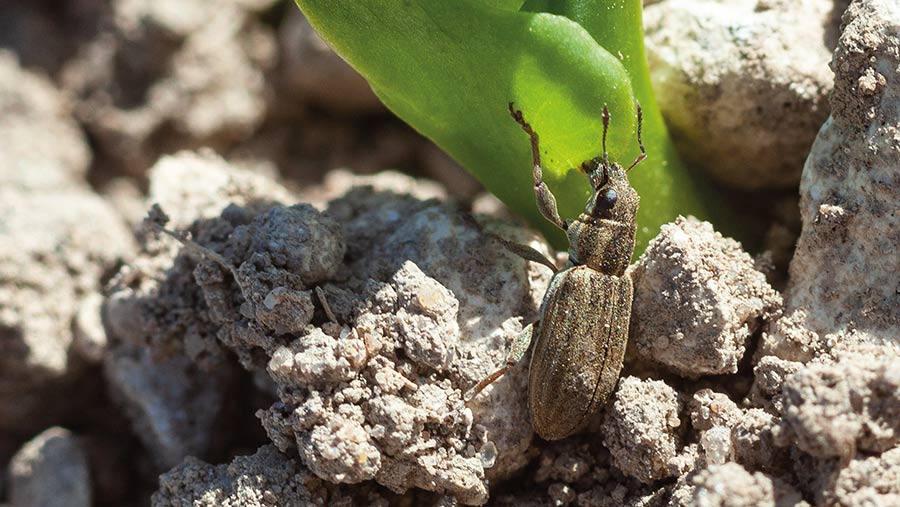4 steps to minimising the risk of growing spring crops
 © Tim Scrivener
© Tim Scrivener Last season was a classic example of the risks associated with spring cropping, as the exceptionally wet autumn and winter resulted in late drilling on many farms, and once sown, some crops then struggled to establish in one of the driest springs on record.
Such weather extremes are increasingly common and highlight the challenges of growing spring crops, whether as a commercial decision, for blackgrass control, or other rotational reasons.
See also: How arable data analytics could counteract the loss of BPS
Andersons consultant Graham Redman says spring crops can stack up well financially given lower growing costs, and they offer wider agronomic and business benefits. “You have to take a whole-farm approach though, and be ruthless with cost control. Don’t just focus on gross margin.”
Spring crops are inherently lower yielding and while variable costs are naturally lower, fixed costs must also be reduced to minimise cost per tonne and financial risk, he says. “For example, if there’s not the same pressure on autumn workloads, can you use a slightly smaller tractor, or perhaps contractors, for some operations?”
There is a multitude of spring crops to consider and strong arguments for growing different crops/varieties to spread risk.
However, many spring crops have relatively small end markets, so growers must examine opportunities and buyer specifications closely before planting, he adds.
Minority crops, such as echium or poppies, for example, often have very specific requirements that may include agronomy protocols. “Always be clear how you’ll sell a crop and how to grow it before deciding, especially as options are limited for niche crops that don’t meet user specifications.”
Below are some key areas to reduce the risks with mainstream spring crops.
Managing risks
- Get soils in good order
- Plan carefully which fields suit spring cropping and consider rotational, business impact
- Spread risk with different crops or varieties
- Consider new varieties with wider drilling windows or better agronomics
- Identify buyer requirements and consider selling forward to ‘lock-in’ a profitable price
- Keep plans flexible
- Drill early, but don’t force crops into poor conditions
- Do everything possible to promote strong establishment and optimum plant population
- Follow agronomy advice, especially where crops are new to the farm
1. Prepare ground well
The starting point for improving the chances of timely drilling and getting crops off to a good start begins the preceding autumn with effective ground preparation, especially on heavy soils that can be slow to dry in spring, says Mr Willmott.
Land should be prepared so that it can take winter rainfall without slumping, capping or becoming waterlogged, but still retain moisture in spring and require minimal disturbance before drilling, he says.
Cover crops can help, although careful species selection and termination timing is needed for best results, and drilling equipment has to cope with extra residues.
The Processors and Growers Research Organisation (PGRO) principal technical officer Jim Scrimshaw adds: “Soil structure and organic matter are the biggest issues for peas and beans, and both crops will soon indicate any underlying problems, so healthy soil and a good seed-bed are essential.
Pulses are no more variable than any other spring crop, so should not be seen as an add-on.”
2. Timing is everything
The longer spring crops are in the ground, the more chance they have to establish a good root system that can build yield and withstand dry weather. However, as Yorkshire-based AICC agronomist Patrick Stephenson says, “conditions are king”.
Growers in drier eastern areas may be able to start drilling from January onwards if soils are dry enough to create a good seed-bed, whereas in wetter regions or seasons, it may not be possible until March.
“Cold soils are not a problem, as seed will sit there and be ready to go once conditions warm up, but avoid mauling crops in to very wet or waterlogged soils.”
PGRO principal technical officer Stephen Belcher urges growers to “plant by conditions rather than calendar date”. “Plant as early as possible, providing conditions are right,” he adds.
In spring 2020, many pea and bean crops were sown late due to the conditions and struggled in the subsequent dry spell, he acknowledges.
Drilling into wet soil followed by a dry spell also increases the risk of foot rot in peas and beans, further demonstrating the importance of good soil structure.
3. Get seed rate right
Underestimating germination and establishment losses and not sowing enough seeds is a common issue in spring crops, especially spring barley, says Mr Stephenson.
“Spring cereals lack the tillering capacity of autumn-sown crops, so cannot compensate for low plant numbers. Establishment varies depending on weather and soil conditions but can often be 50-60%, yet many growers sow 250-300/sq m on the assumption they’ll get 85-90% establishment.
“An average seed rate of 175kg/ha therefore probably needs to be nearer 190-200kg/ha, which is more than people are normally comfortable with.”
Mr Belcher says 50-55 plants/sq m is a good target population for spring beans, although this should be tailored to soil type and yield capacity of individual fields. “Generally seed rates for pulses are about right, although some crops can be slightly thick where seed-bed losses have been overestimated.”
This is more problematic in dry seasons when too many plants compete for limited moisture and nutrients, he notes. “Seed rate must be appropriate to the conditions.”
4. Avoid restrictions to growth
Experts are clear that once crops are sown, nothing should limit growth given the short growing season of just five to six months.
Adequate nutrition is vital during establishment, particularly nitrogen, phosphorus and potassium. PGRO research shows beans respond particularly well to potash, so good soil Indices should be maintained or topped up where required.
For spring cereals, particularly barley, the bulk of nitrogen should be applied early by the start of tillering (GS21), with total rates and growth regulator strategy balanced against yield potential and lodging or brackling risks, Mr Stephenson adds.
“For most spring barley, 125kg N/ha is enough to get you to 6-8t/ha. For oats, I’d be nervous about applying more than 80-100kg/ha.”
Starter fertilisers applied with seed at drilling could boost nutrient availability to emerging seedlings, although the cost and need for appropriate equipment must be weighed against potential returns, which can vary by location, soil fertility, crop and season.
Likewise, the jury is still out on biostimulants. “A lot of products have shown benefits to rooting in controlled experiments, but it remains to be seen whether that carries through to extra yield in a field situation,” says Mr Willmott.
Applying diammonium phosphate (DAP) before or straight after drilling is a cheaper option, although may not offer the same uptake efficiency as placed fertiliser, Mr Stephenson notes.
There is some debate about pre-emergence herbicide applications in spring crops, given concerns about potential effects on crop establishment. Mr Stephenson favours a peri-emergence spray instead, allowing crops to germinate and start growing first.
However, growers must not let weeds stifle crop establishment, so in some cases, such as where there are high levels of grass weeds, or limited chemistry options, a pre-emergence may be the best route, adds Mr Willmott.
Managing pulse pests and disease

© Blackthorn Arable
There are three main pest threats that must be managed well to maximise returns from spring pulses, the Processors and Growers Research Organisation’s Becky Howard says.
Pea and bean weevil is generally a greater threat to early-sown crops as the pest is usually active from February onwards. There are issues with pyrethroid resistance, so she encourages growers to use trap monitoring to check if/when treatment thresholds are met.
Early aphid activity presents a virus transmission risk in all pulses, and with the loss of thiacloprid from February 2021, control is limited to a single aphicide (pirimicarb), she notes.
Bruchid beetle is another serious threat, with damage potentially preventing crops going into human consumption markets. Dr Howard says incidence tends to be higher in winter crops than spring, and early spring sowings may be at more risk than those sown later.
The BruchidCast forecasting system provides an early warning of pest activity to help application timing.
“Often where growers are not getting good control it is due to temperatures in May and June, but there is also resistance to pyrethroids in bruchid populations, so many growers are choosing not to apply insecticides.”
Chocolate spot is the main disease risk to beans in wetter springs/summers, while rusts are a greater concern in hot, dry years, usually later in the season. “Even without chlorothalonil, there is a good range of fungicides to control both diseases,” Dr Howard concludes.

